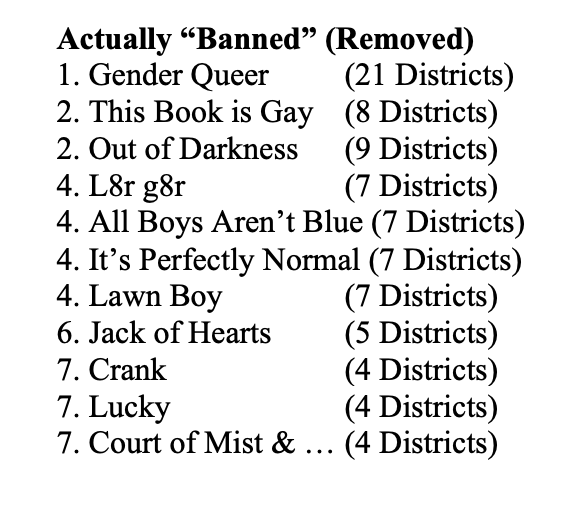Is there really widespread book banning?
According to the 101-year-old organization PEN America, long considered the defender of free expression, there is.
Headquartered in New York City, the advocacy organization describes itself as a protector of “free expression” in the United States, and is “the primary source for claims that there is widespread book banning underway in American schools,” write Jay Greene, Max Eden, and Madison Marino for the Educational Freedom Institute in their report “The Book Ban Mirage.”
Definitions matter
But these claims hinge on PEN America’s definition of “banned,” which Greene, Eden and Marino point out isn’t the more commonly accepted definition of making something unavailable.
In fact, books labeled as “banned” can still be accessible to students, as any book that is challenged, even if it doesn’t end up getting removed from the classroom or library, is then considered to be a “banned” book, according to the American Library Association and reported by ABC News.
Even if school staff reclassifies a book, say, for a more age-appropriate section, PEN America will claim that action constitutes the book being “banned,” explain Greene, Eden and Marino. According to PEN America, a school book ban is
any action taken against a book based on its content and as a result of parent or community challenges, administrative decisions, or in response to direct or threatened action by lawmakers or other government officials, that leads to a previously accessible book being either completely removed from availability to students, or where access to a book is restricted or diminished. [Emphasis added.]
So, if a book is temporarily removed from a school’s library shelves for review, and then returned, PEN America claims that book has been banned, continue Greene, Eden and Marino.
If a book is removed from a school library but is still assigned in English class, then by PEN’s definition, that book has been banned. If a book is made unavailable in a middle school library but is still available in a high school library, then by PEN’s definition, that book has been banned. If a book is moved to a special section of the library or to a school counselor’s office, then by PEN’s definition, that book has been banned. If
a book is removed from the assigned curriculum or an optional additional reading list but is still available in the school library, then by PEN’s definition, that book has been banned. It is also impossible to discern from PEN’s data files whether a book listed as “banned” was ever available in the school library at all.
Most “banned” books are still available
Even if one accepts this misleading definition of “banned,” the authors put PEN America’s “banned” books data in perspective. As of PEN America’s September 2022 report, there have been 2,532 instances of book “bans” in 138 school districts — so, not even 1 percent of American school districts. And, as the authors document, most of that count is skewed by three outlier districts: Central York School District (PA), 439 book “bans”; North East Independent School District (TX), 434 bans; and Collierville School District (TN), 326 bans. “Thus, 47 percent of PEN’s national figure comes from three school districts serving a total of approximately 75,000 students (0.15 percent of America’s 50 million).”
Greene, Eden and Marino then dug into PEN America’s list of books “Banned – Pending Investigation,” “Banned in Libraries,” or “Banned in Libraries and Classrooms” and compared that to online school library card catalogs. The results? Seventy-four percent are listed as available in the school district libraries where PEN America said they were banned. Classic works, such as Anne Frank’s Diary, Brave New World, Lord of the Flies, Of Mice and Men, The Color Purple, and To Kill a Mockingbird, that PEN America said were banned were also listed as available. (In the same vein, read my posts here and here about Gov. Tim Walz’s book “ban” claims.)
So, what books have been removed?
There were a handful of books that PEN America had on its Top 10 “banned” books list that the authors were also unable to find in the corresponding school district library catalogs. If you look up these titles, though, you will discover that they contain sexually explicit, obscene content “that few reasonable people would insist belong in a school library,” write Greene, Eden and Marino. (In case you doubt what is being considered as sexually explicit, the authors reproduced images and text in Appendix A of their report.)

In fact, television stations have cut away from press conferences on these books when the content is shown and school boards have cut off parents reading excerpts during public comment periods.
This is not about preventing students from accessing diversified literature, this is about public school libraries having non-age-appropriate books available to children.
It’s baffling that protecting children from explicit material while in school is controversial.
And what about the books not on school library shelves? There is only so much space for so many books.
Conclusion
Despite attempts to associate moving or removing sexually explicit content with that of book-burning totalitarian regimes, Greene, Eden and Marino’s research concludes that there are few actual book removals. “A careful examination using the conventional definition reveals that only a fraction of ‘banned’ books are no longer present, and that the most-banned books are all sexually explicit material.”
Parents, use this online library catalog to search for books in your child’s school and/or district. And check your district’s policy regarding instructional materials, as a district is supposed to have a procedure in place for handling concerns or challenges regarding instructional materials. For example, parents can make a request for reconsideration of instructional or library materials. Here is the Fargo school district’s policy on the topic.